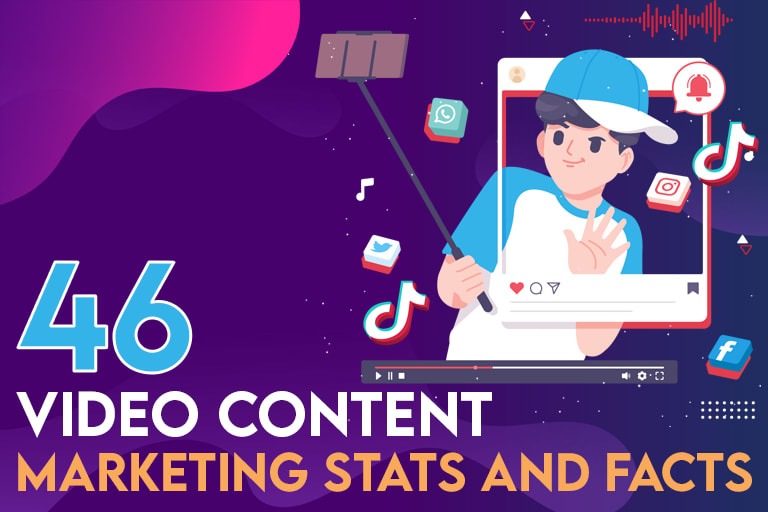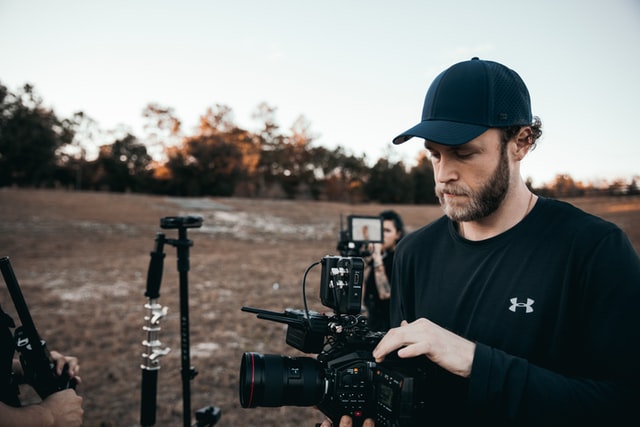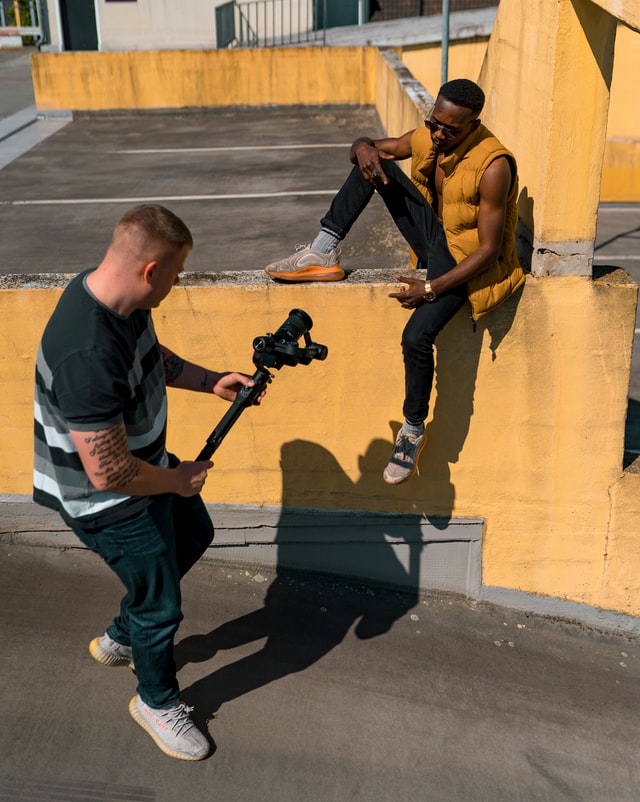We’re House of Marketers, an influencer marketing agency that specialises in running TikTok influencer video campaigns for the biggest brands and most promising startups worldwide. Our founders include an early TikTok employee and an early agency partner of global video social media platform, Tik Tok. TikTok is the world’s best app for content creators and the most engaging video medium brands use to engage communities. In order to conquer social media, mastering video is so important. So we’ve put together 46 video content marketing stats and facts that will help guide us through your video content marketing journey.

With consumer habits changing and production barriers falling, there has been a significant movement to online video in recent years. YouTube has become colossal – its search engine is second only to Google itself. Most of the other social networks have rushed to add video capabilities to maintain and grow their market share – most recently with Instagram’s introduction of IGTV. Additionally, the arrival of TikTok has paved the way for brands and influencers to make stunning content that is incredibly engaging and creative. It makes sense, therefore, that video content marketing should now be an essential part of the marketing mix for most firms.
The importance of video content marketing
So just how important is video content marketing? We’ve taken a look at the social landscape and collated 46 critical video content marketing stats and facts.
Video is far more than a passing fad. It is changing the way we all live and consume content. That is why our team at House of Marketers are big advocates for incorporating video in influencer marketing campaigns. Organic TikTok video content and TikTok video ads should be an integral part of most company influencer marketing strategies.
The 46 Video Content Marketing Stats you should take note of
Video Helps Attract New Customers
- 80% of marketers say that integrating video content marketing has increased dwell time on their website. This is according to Wyzowl who surveyed 570 marketing professionals and online consumers.
- Businesses and marketers who used video grew revenue 49% faster than non-video users according to Vidyard’s 2018 Video in Business Benchmark Report.
- Wyzowl reports that 97% of marketers believe video has helped increase user understanding of their product or service. 76% believe that it helps increase both traffic and sales.
Video Engages Potential Customers
- 4 times as many consumers would prefer to watch a video about a product than they would to read about it. (Social Media Today). Clearly, the video makes it easier to see a product in use. It is also simpler to see a physical product from a range of angles in a video than if you have to rely on still images.
- This one won’t surprise you, but here it is anyway. The shorter the video, the larger the percentage of the audience left at the end, according to Vidyard ’s research. 59% of the viewers survive to the end on videos shorter than 90 seconds. Longer videos see more of a drop-off rate, however, with only 14% making it all the way through 30-minute videos or longer.
- 52% of consumers say that watching product videos makes them “more confident in online purchase decisions.”
- 62% of people pay attention to video – the highest for any type of media, according to Hubspot only 38% claim they skim or multitask videos. This compares to news articles (61% attention, 39% skim), social media posts (56% attention, 44% skim), research reports (49% attention, 51% skim), email content (44% attention, 56% skim), ebooks (36% attention, 64% skim), blog articles (27% attention, 73% skim, and podcasts (22% attention, 78% skim).

Video Encourages People to Return
- 43% of Hubspot’s respondents believe that branded video content is the most memorable type of content This compares to 36% who favour branded photo content and 18% (predominantly older people) who prefer branded written material.
- 54% of Hubspot’s respondents would prefer to see videos from brands that they support. This compares to 6% who opt for emails/newsletters, 41% social images, 34% social videos, 18% blog articles, and 17% who prefer downloadable PDFs they can read later.
- Watching a brand’s videos is second only to going to a website as the preferred way for people to engage with the brands they know. Hubspot found that although 67% of people went to a brand’s website to learn more about the business, 41% chose to watch their videos. Every other method was lower still.
Video Helps Trigger Emotions
- Campaigns with purely emotional content perform about twice as well (31% vs 16%) as those with only rational content and a better even than campaigns that mix emotional and rational content (26%). Video content has strong emotional power. By making use of it, you can encourage potential customers to take action in the direction you want. By creating an explainer video, you can trigger different emotions in your audience, generating a powerful connection and empathy.
- People share videos twelve times more than they do text and images combined. Many top brands use customer success stories to create viral videos.
- 83% of Wyzowl’s survey respondents admit that they would happily share a branded video with their friends if they enjoyed it.
Usage of Video Content
- YouTube has over one billion users. That is nearly one-third of all the people who use the internet. These users watch over a billion hours of video each day.
- YouTube on mobile alone reaches more than cable television does in the USA, in both the 18-34 and 18-49-year-old And that doesn’t even include video-mad Generation Z teenagers, who have grown up using YouTube as their primary source of entertainment.
- People are 1.5 times more likely to watch video daily on a smartphone than on a computer. Millennials are 1.35 times more likely than their elders to say that they find it easier to focus when watching videos on mobile. 71% of people surveyed in the UK and UAE believe their online video viewing has increased over the past year
- The average consumer watches more than an hour and a half of online video content per day, according to the survey undertaken by Wyzowl. Around 15% on average more than three hours.
- People gaze five times longer at video than static content on both Facebook and Instagram. And this survey was taken before the introduction of IGTV which will extend the time people spend watching videos on Instagram.
- According to Facebook’s own 2017 statistics, daily watch time for Facebook live broadcasts grew four times over the course of a year. One in five videos is now a live broadcast.
- The largest users of online video content are in Saudi Arabia and Turkey. 95% of internet users in those countries watch online video on any device. (Statista). The highest Western country is New Zealand at 92%. 85% of the people in the USA watch online video. The top Western European country is France at 81%. Surprisingly, the UK does not make into the Top 20 list, with fewer than 64% watching online video on average. However, we at House of Marketers, expect this to reflect the lack of video content in the UK, in comparison to other countries – Take advantage of your competitors!
- Snapchat receives 5 times the swipe-up rate compared to the average CTR on comparable platforms, according to internal Snapchat research. The best snaps have vertical video, last up to 10 seconds, and are viewed by choice.
- Yet the Wyzowl survey indicates that Snapshot is struggling to build a real following n video content Just 11% of the marketers surveyed used Snapchat video in 2017, and this was predicted to fall even further to 9% in 2018.
- The number of marketers sharing video content on LinkedIn was around 38% in late 2017, according to Wyzowl’s survey. 2018 was predicted to be a breakout year for LinkedIn video with this figure expected to rise to 55%.
- 86% of businesses use video on their website, and 77% use video on social media, according to Vidyard’s survey. Also, 60% of companies use video on landing pages, 46% use It in emails, and 37% in sales conversations.
- 26% of US internet users watch YouTube several times per day (Statista). A further 12% check their YouTube once a day. 16% go on YouTube every few days, and 9% once a week.

Who Uses Video Content Marketing?
- 60% of B2C marketers say that they consider video to be the most critical tactic for their content marketing success. (Social Media Today). 85% also found social media content to be significant. When you combine those two statistics, it is clear that video content marketing, shared across social platforms is thought to be vital to the success of B2C marketing success in the eyes of many companies.
- Wyzowl found that 81% of businesses use video as a marketing tool. This is up from 63% in their 2017 survey. Of the businesses that currently engage in video content marketing, 99% say they will continue to do so over the next year. 85% of them regard video to be an important part of their marketing strategy (up from 82% last year). 82% plan to spend more on video marketing over the next year. 78% of the surveyed marketers believe that video gives them a good ROI.
- High Tech companies have posted an average of 637 videos, according to Vidyard ’s report. This is substantially more than most sectors, however. The average videos per company in some other industries are Professional Services 274, Media, Entertaining & Publishing 247, Food & Leisure 245, Education & Public Services 162, Healthcare 150, Financial Services 145, Manufacturing 131, Communications 84, and Retail 56.
- The average number of videos published by businesses as of the end of 2017 was 33 per month, according to Vidyard’s 2018 survey. This is almost double the previous year’s average of 18. High tech companies average 53 videos per month. Most other industries produce from 23 (Professional Services) to 5 (Retail) videos in an average month. The sectors which have experienced the greatest increases in video production over the last year are High Tech, Professional Services, Financial Services, and Healthcare.
- 72% of B2B organisations use pre-produced videos as part of their content marketing efforts. Other highly supported types of content are (non-video) social media 94%, case studies (73%), eBooks (71%), infographics (65%), and illustrations / photos (56%).
Types of Video Content
- 63% of businesses invest in product videos, according to Vidyard’s survey. The next most popular types of videos that businesses create are demos (59%), explainer videos (54%), webinars (45%), how-to / educational videos (42%), social media videos (38%), customer videos (37%), live stream (24%), culture videos (23%), vlogs (13%), one-to-one videos (12%), and chalk / whiteboard videos (7%).
- Product videos are the most common type of videos on landing pages, websites, and social media, according to Vidyard data. Demo videos are more common in emails and sales conversations, however.
- Wyzowl discovered that 95% of people admit to watching an explainer video to learn more about products and services.

Video Content Marketing Trends for 2018 and Beyond
- Generation Z dislikes ads so much they won’t watch them, even on their preferred platforms. This is one of the reasons we believe that TikTok influencers are perfect for targeting Generation Z. Today’s teenagers would prefer to spend more time on YouTube, Tik Tok, or Twitch than they do watching traditional television. We expect today’s youngsters to add IGTV to this list very shortly. If your target market is Generation Z, it makes far more sense to use video content marketing than it does television advertising, and it is much cheaper, too.
- 64% of all Tik Tok users (musers) are aged under 24. They are predominantly female, with 75% of the platform’s users being young women. This makes musical.ly a platform of choice for companies targeting this demographic
- 5% of Twitch users are male and aged between 18 and 24 (Twitch Advertising). Twitch is the online social platform of choice for gamers. Marketers have already discovered the benefits of influencer marketing on Twitch. Although it has an obvious synergy for gaming companies, it has become popular with companies who sell any of the types of products loved by typical gamers, for instance, fast foods and soft drinks.
- By 2021, video traffic will account for 82% of all consumer Internet traffic according to Cisco research. It would take an individual more than 5 million years to watch the amount of video that will cross global IP networks each month in 2021. Every second, a million minutes of video content will cross the network.
- 53% of people claim they want to see more video content according to Hubspot research. This is the highest type of content – the only category over 50%. However, these stats do vary according to age. 65% of young consumers (18-24) want more video content, compared to only 43% of those 55 or older. On the other hand, 30% of the older generation would prefer more email content, compared to just 17% of Millennials.
- According to the marketers polled in Wizowl’s survey in December 2017, 87% intended to use Youtube in 2018. Other types of video they planned to use this year include Facebook video 70%, webinars 49%, Instagram video 44%, Twitter video 40%, LinkedIn video, 55%, and Facebook Live 37%. 14% of the marketers were clearly forward-thinking and intended to work with VR in 2018.
- By 2020, over 75% of the world’s mobile data traffic will be video. Recent generations of mobile internet speeds have made video usable on mobile phones. “By 2020, over 75% of the world’s mobile data traffic will be video. Recent generations of mobile internet speeds have made video viable for regular mobile usage.”
Video Content Marketing Best Practices
- Pre-loaded Web Views generate an 80% lift in on-site time on Snapchat, according to Snapchat internal research. Snap Ads Web View provides advertisers with a way to drive Snapchatters to the brand’s pre-selected mobile site using a slick, full-screen experience.
- Using video on landing pages can increase conversion by 80%. Why? Videos increase the length of time people stay on a page, giving the brand message longer to sink in. Featuring the business owner(s) or company employees in the video raises the trust factor significantly. And when it comes down to it, people are naturally lazy and often prefer to watch rather than read.
- Produce shorter videos if you want people to take notice of your message. According to the Independent, the average British person has an average attention span of just 14 minutes. The average adult loses concentration when watching television – usually to look at a mobile device – after just seven minutes. As an aside, we were interested to discover that the mother-in-law can only command seven minutes of attention before her son or daughter-in-law tries to finish a phone call with them.
Video Content Influencer Marketing
- In one of the House of Marketer team’s earliest influencer marketing campaigns, we collaborated with a top influencer, creating a viral video hit. The video generated more than 10 million video views in 48 hours. The client wanted to raise awareness amongst chicken buyers across the UK – and that’s exactly what we did through the power of video. This took product placement to another level, ultimately gathering more than 12 million video views in the process. The video demonstrates the sheer power of well-produced video content in the influencer marketing space.
- The official Universal trailers for ‘Jurassic World: Fallen Kingdom’ generated 139M YouTube views, and an average engagement rate of 0.8x. This is just below the average for YouTube content. Influencer videos on YouTube for ‘Fallen Kingdom’ generated 197M views and 3 times the engagement rate.
- A rap about refilling a Brita spread by influencers led to over 2 million views and a 2,000% mobile search lift. Clorox brand Brita paired up NBA superstar Steph Curry with YouTube creator and social influencer King Bach. They produced a funny video that performed exceptionally well.
Up your Video Content Marketing Strategy
We hope the article you just read provided you with some great insights. Now it’s time for you to go and implement video in your content strategy.
If you’d like some guidance with your influencer marketing video strategy, contact the UK’s most talented influencer marketing strategists here.

House of Marketers (HOM) is a leading TikTok Marketing Agency. Our global agency was built by early TikTok Employees & TikTok Partners, which gives us the insider knowledge to help leading brands, like Redbull, Playtika, Badoo, and HelloFresh win on TikTok. Want us to convert more of Gen Z and Millennials with TikTok? Get in touch with our friendly team, here.